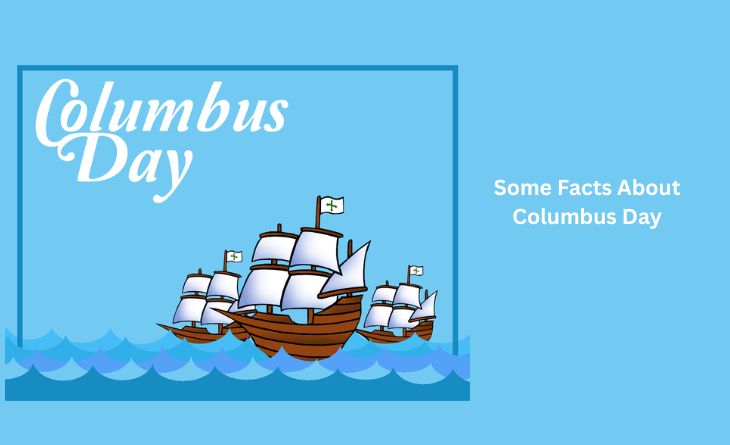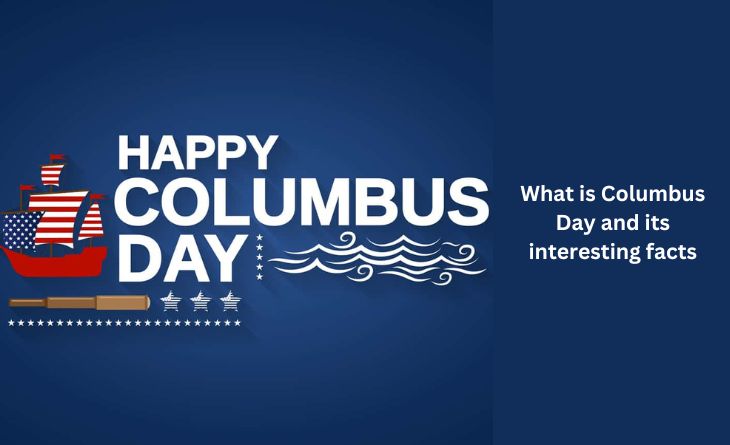In this article, we share detailed information on Columbus Day and its interesting Facts.
Columbus Day is a national holiday in the United States that honors Christopher Columbus’ arrival in the Americas in 1492.
In 2023, it falls on Monday, October 9.
Although it was unofficially observed in several towns and states as early as the 18th century, it wasn’t until 1937 that it was declared a federal holiday.
The event serves as a means of both celebrating Italian-American heritage and honoring Christopher Columbus’ accomplishments.
However, controversy has surrounded Columbus Day and the man who inspired it throughout its history.
Since the 1970s, various alternatives to the holiday have been offered, including Indigenous People’s Day, which is now observed in many U.S. states and localities.
Contents
Some Interesting Facts About Columbus Day

1. His real name was not Christopher Columbus. He was actually given the name Cristoforo Colombo when he was born in Genoa.
2. The Meaning of Columbus Day
Columbus Day honors Christopher Columbus’ arrival in the New World, specifically the Americas, in 1492.
Before it was made a federal holiday, Columbus Day was unofficially observed in many cities in the 18th century.
Many people believe that the purpose of Columbus Day is to honor the accomplishments of the explorer who bears his name.
3. The Resting Places of Christopher Columbus
Columbus was destined to be an adventurer. At the youthful age of fifteen, he learned to sail.
The Americas were his most well-known (or infamous) destination, and he traveled there in three ships: the Nina, the Pinta, and the Santa Maria.
Two of the ships would eventually return to Spain, but the Santa Maria ran aground off the coast of Haiti.
Columbus, who had made three additional voyages to the New World, passed away at the age of 55 in 1506.
Only two years had passed since his last excursion to the New World.
4. Unique to Italian Americans
Columbus Day is not only a celebration of Columbus’ accomplishments but also a significant event for Italian-Americans.
Although Spain funded his travels, Columbus was actually Italian-born and from Genoa.
Today, a lot of Italian-Americans celebrate their heritage on Columbus Day.
5. What Is Controversial About Columbus Day?
Even while Columbus Day has been observed for a very long time, its origins are controversial.
Christopher Columbus is revered as an explorer by some.
Others, however, saw him as a colonizer.
Despite the fact that he did “discover” the New World, the impact of his arrival included the enslavement and murder of numerous Indigenous peoples.
He also forcibly seized Native Americans’ land, whom he referred to as “Indians.”
6. The First Was Colorado
On April 1, 1907, Colorado became the first state to formally declare Columbus Day a holiday.
This shouldn’t come as a surprise given that the Italian adventurer is even honoured by a large city in Colorado.
Colorado was quickly followed in 1909 by New York.
Then, in 1934, Columbus Day was made a federal holiday by President Franklin D. Roosevelt.
7. Not All States Celebrate Columbus Day
Many states and communities have discontinued celebrating Columbus Day entirely as a result of its contentious past.
Instead, Indigenous Peoples’ Day has been formally substituted.
For instance, Alaska started celebrating Indigenous Peoples’ Day in 2017.
Notably, South Dakota was the first state to do this in 1990. Vermont and Oregon are some other states.
Some states further observe Indigenous Peoples’ Day in addition to Columbus Day.
8. Outside of the US Only
The fact that other countries also celebrate Columbus Day may be among the most intriguing trivia about the holiday.
Other countries also observe the occasion.
Most Spanish-speaking nations refer to it as Dia de la Raza, which translates to “Day of the Race.”
The day is known as Fiesta Nacional or Dia de la Hispanidad in Spain. People in the Bahamas observe it as Discovery Day.
Along with Columbus Day, Indigenous Peoples’ Day is a widely observed holiday worldwide.
In reality, August 9 of each year is designated as the International Day of the World’s Indigenous Peoples.
The objective is to increase respect for and protection of the rights of indigenous peoples around the world.
Additionally, it honors indigenous peoples’ numerous contributions and accomplishments.
9. The Celebration of Columbus Day
While Columbus Day celebrations might differ from place to city, parades are one of the most well-liked methods to mark the occasion.
Columbus Day has been observed the same way in New York and Chicago, two cities renowned for their lively parades.
Some parades honor the heritage of Italian Americans in addition to Columbus Day.
Many Americans get Monday off as well, so they usually take advantage of the long weekend to travel and celebrate the holiday.
10. Holiday that is least observed
The fact that Columbus Day is the least recognized federal holiday in the US is one of the event’s most intriguing facts.
This is large because many states do not formally recognize the holiday because of its contentious past.
Banks and non-essential government offices do close on Columbus Day, but the majority of companies are open.
The majority of states likewise let their schools out for the day.
11. Columbus’ illustrious journey
His journeys were unsuccessful on half of them.
On Columbus’ illustrious journey of 1492, the Santa Maria, his main ship, fell aground and sank, forcing him to abandon 39 men to the village of La Navidad.
He was expected to return to Spain with a cargo of expensive goods, including spices and other items, as well as information on an important new trade route.
Instead, he failed to take the best of the three ships entrusted to him and instead came back empty-handed.
In his fourth expedition, his ship began to deteriorate, leaving him and his crew marooned in Jamaica for a year.
12. Queen Isabella hesitated to provide funding for Columbus’s journey.
She didn’t agree for six years.
When the Queen’s courier caught up with Christopher Columbus and broke the news to him, he had given up and was four miles outside of town.
Even after receiving the funds and the ships, Columbus struggled to find a crew.
Many people still held onto the myths that the earth was flat and that a ship would eventually run into a waterfall and plunge off the side of the planet.
Other Facts
13. He received three ships from the city of Palos before embarking on the mission.
14. There were 90 men on his crew.
15. The expedition’s objective was to map a western sea path to Asia’s islands that were rich in gold and spices, as well as to India and China.
16. The first European to have the chance to explore the Americas since the tenth century was Christopher Columbus, who made his first landing in the Bahamas in 1492.
17. The Santa Maria ran aground on Christmas Day, preventing it from making the journey back to Spain.
There was no room aboard the other two ships, so 40 soldiers had to stay behind. They remained on the continent of Hispaniola.
18. Three trips were taken by Christopher Columbus to the New World.
Only two years had passed since his last expedition to the New World when he passed away at age 55 in 1506.
19. On August 3, 1492, Christopher Columbus’s first expedition with the Santa Maria, Nina, and Pinta set out.
A sailor aboard the Pinta yelled “Tierra!” or “Land!” on October 12, 1492.
20. 375 miles off the coast of Florida, Christopher Columbus and his crew were really able to see the island of San Salvador.
21. Christopher Columbus gave a seasoned youngster command of the Santa Maria on Christmas Eve, and that evening the ship slammed into a shoal close to Hispaniola.
The Nina and Pinta would be the only ships to reach Spain.
22. Christopher Columbus never truly set foot on the continent of North America, despite making three voyages back west.
23. Columbus passed away in Spain in 1506, and after some time, his remains were moved to Santo Domingo in 1537.
They stayed there until 1795 when they were transported to Havana, and it is believed that they returned to Spain in 1898.
However, a casket of bones carrying his name was discovered in Santo Domingo in 1877.
Since that time, his remains have been claimed by Santo Domingo and Seville, Spain.
The bones in question are kept in magnificent mausoleums in each city.
Read
What is Columbus Day and why it is celebrated?
What is Veterans Day and why is it celebrated?
- Understanding HIPAA Compliance: Obligations for Covered Entities and Business Associates - April 23, 2024
- Things to Invest in for the Easter Season in 2024 - March 29, 2024
- Why Experience Matters: Finding An Established Dental Implants Provider - March 29, 2024
